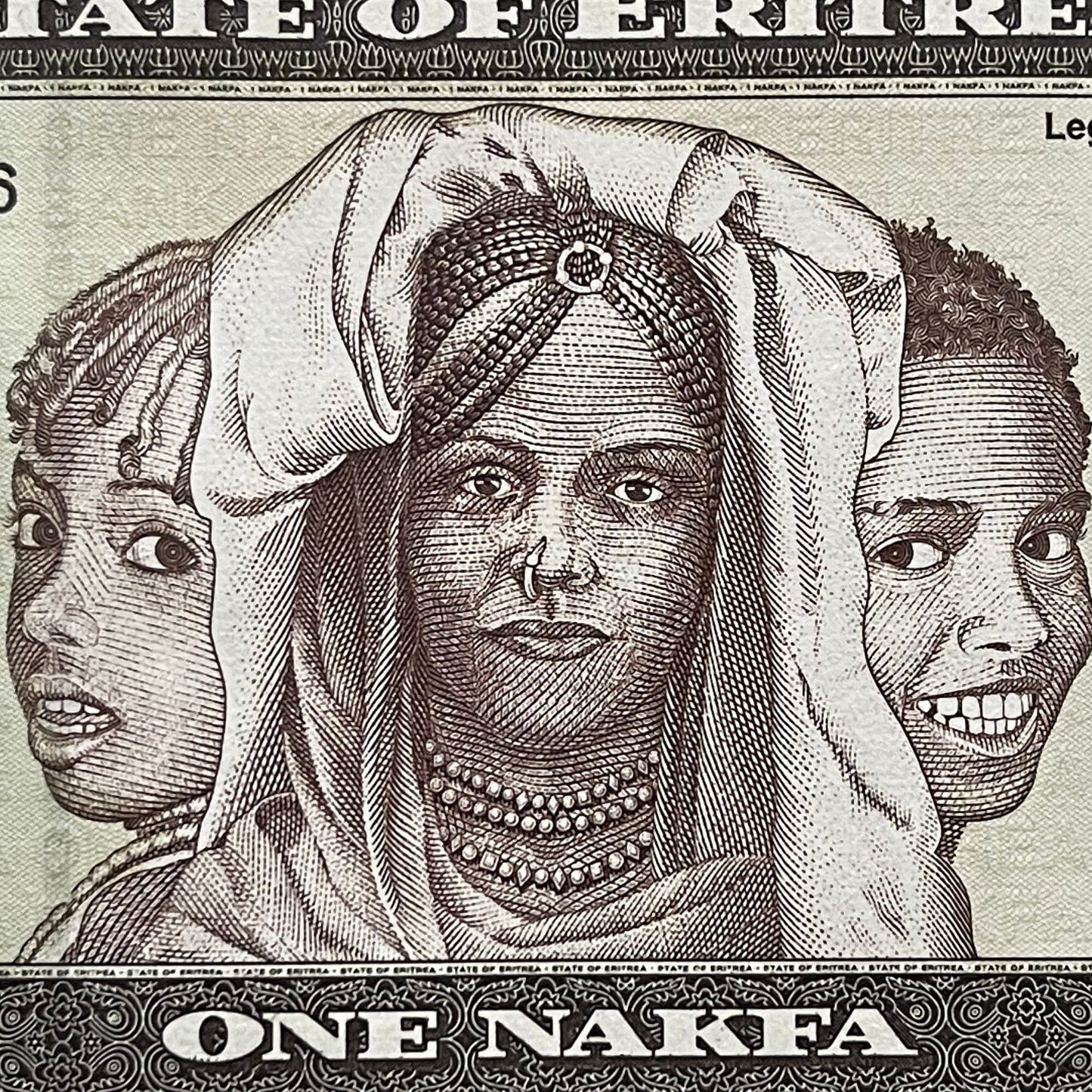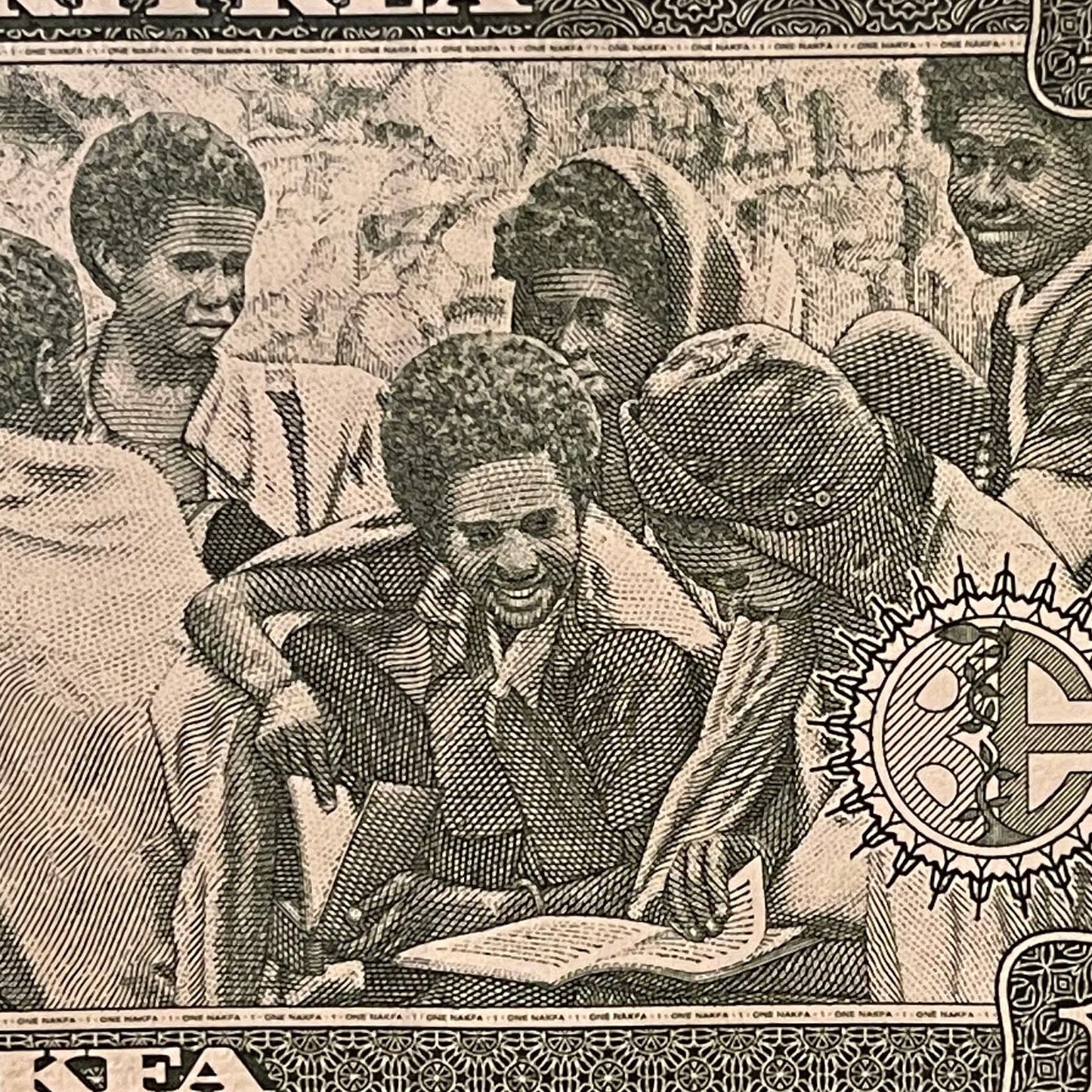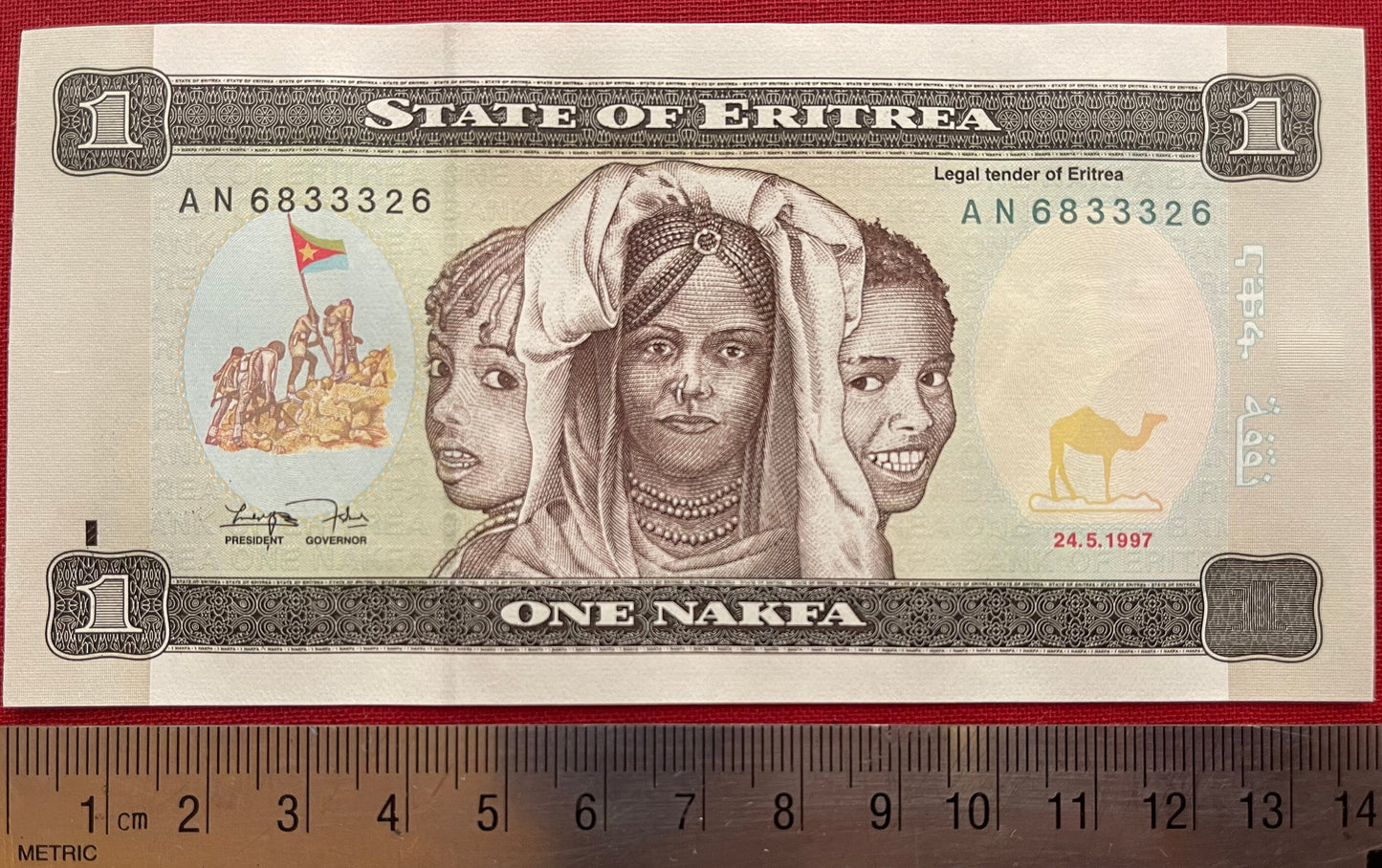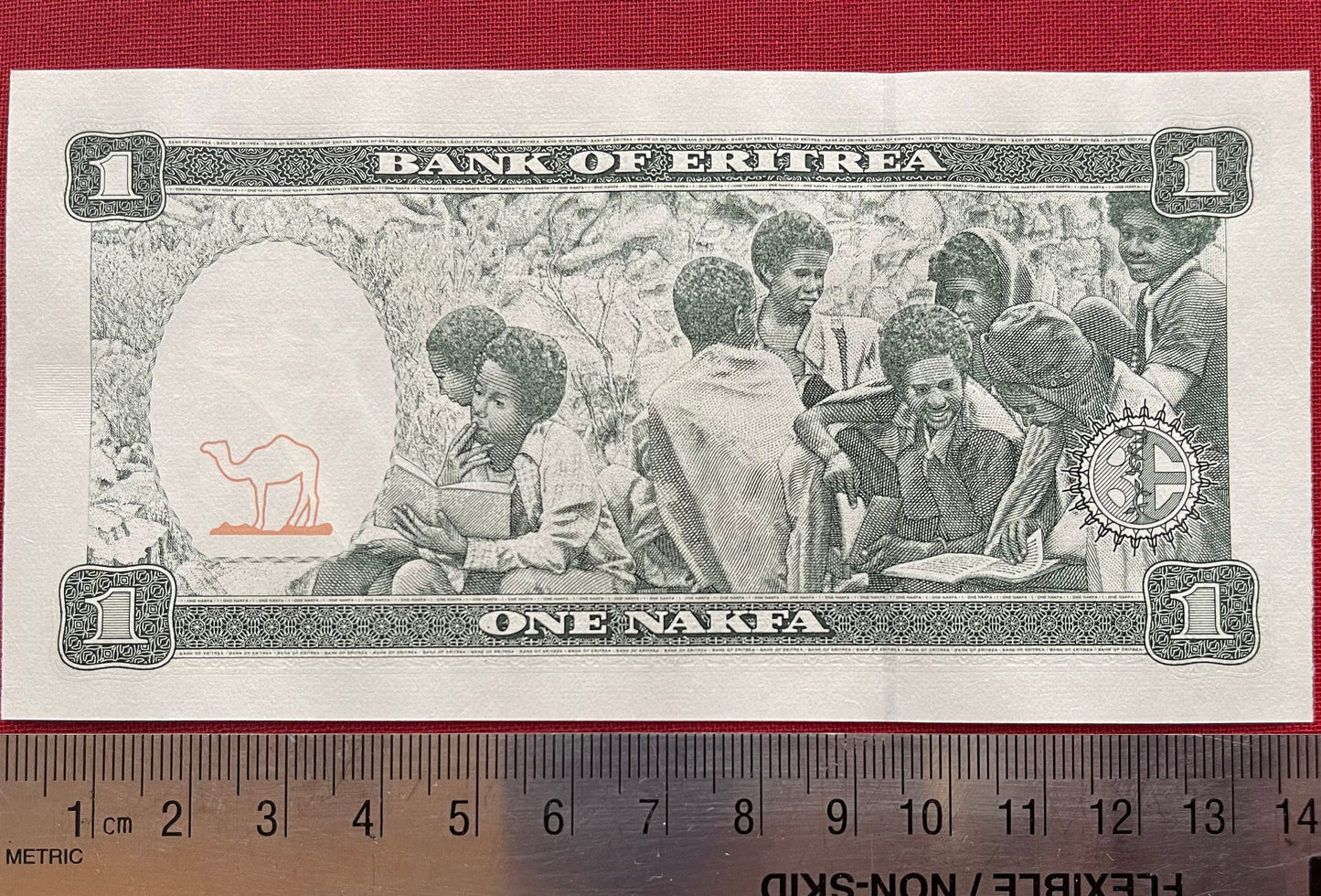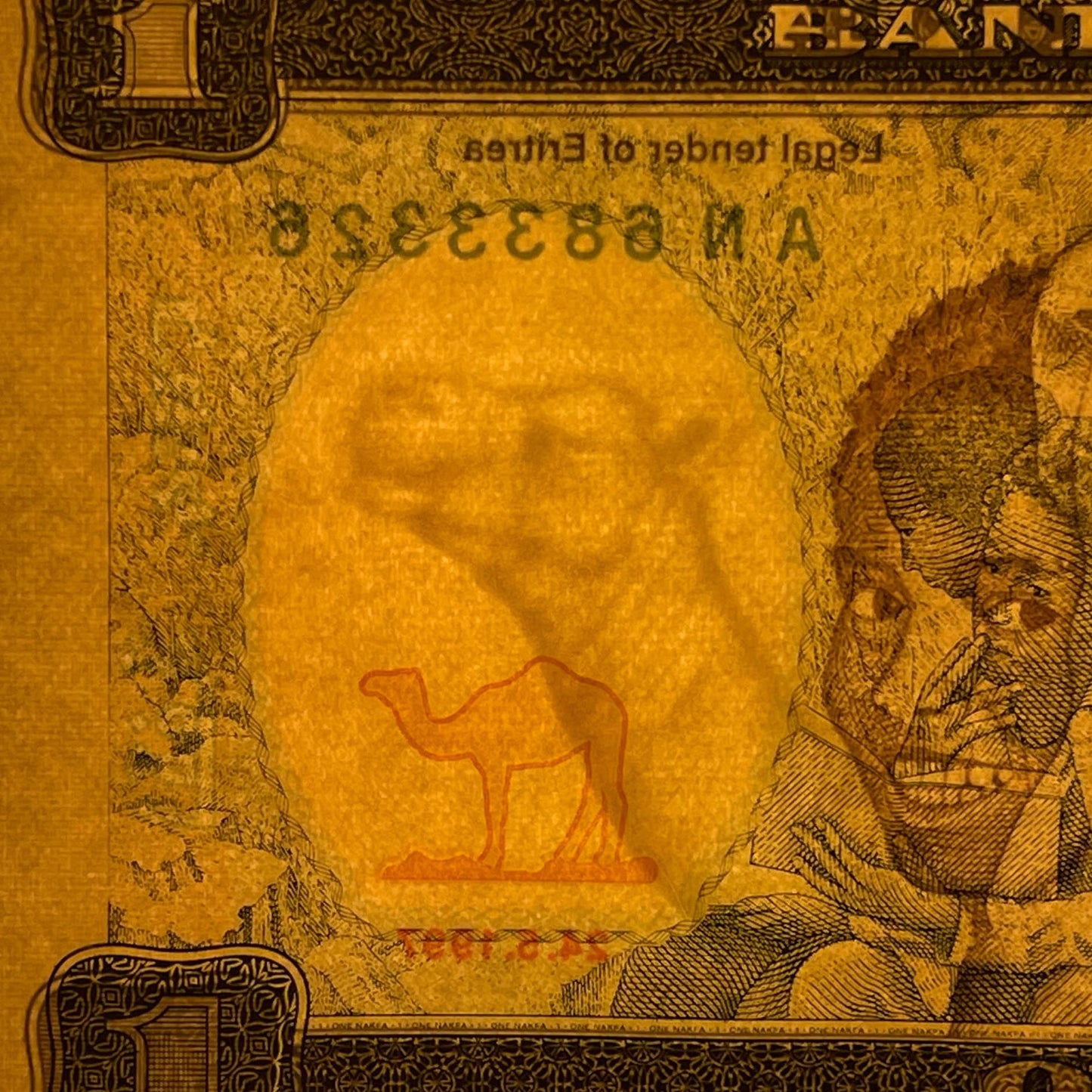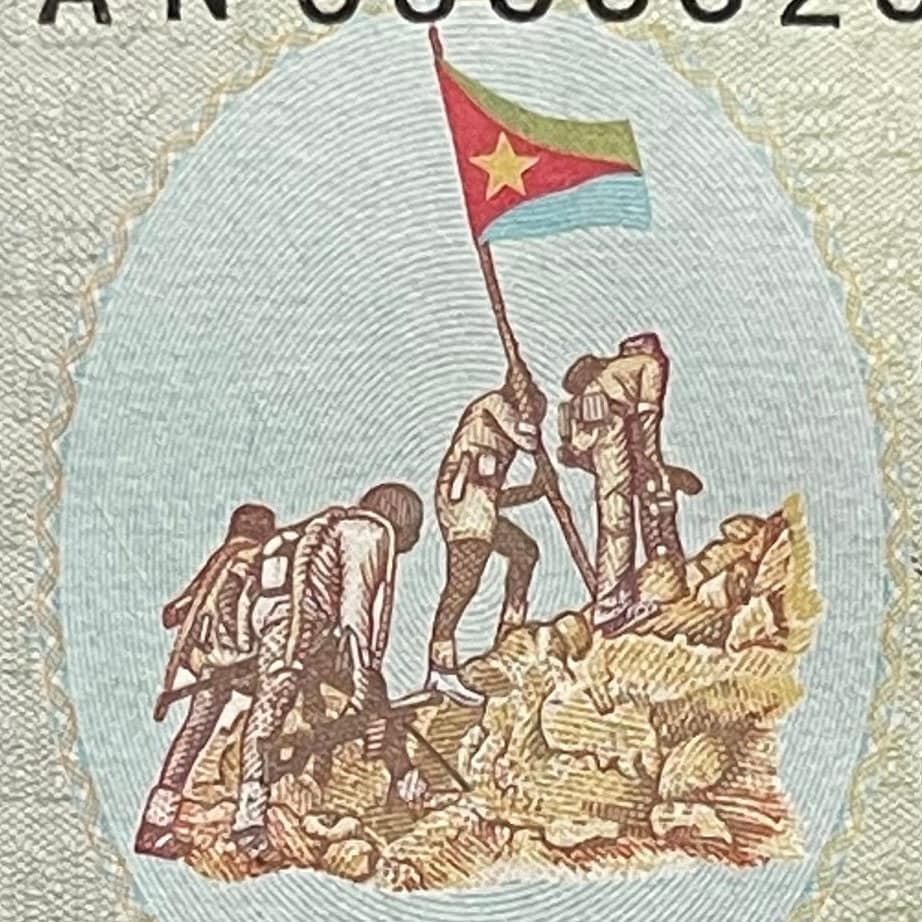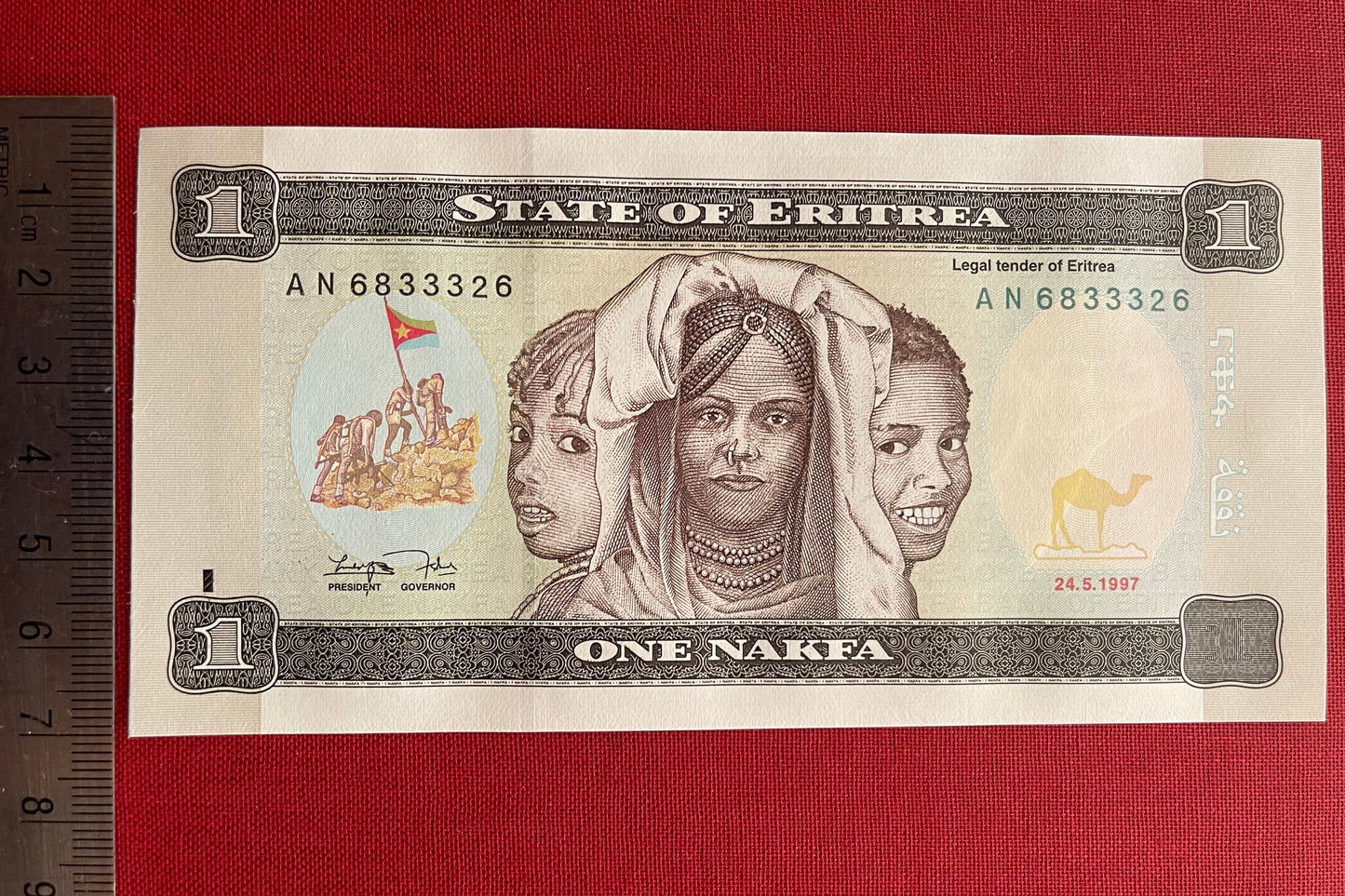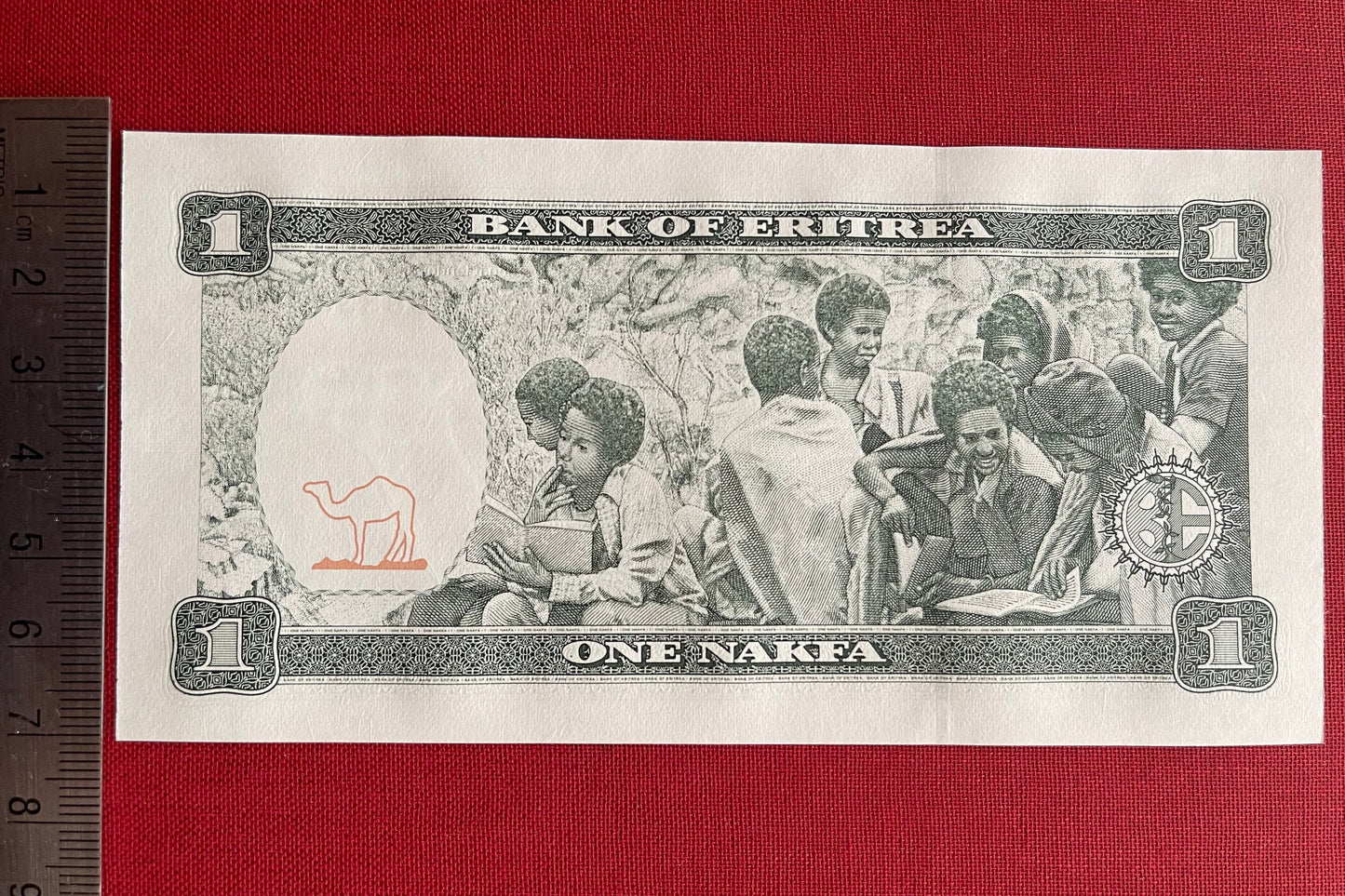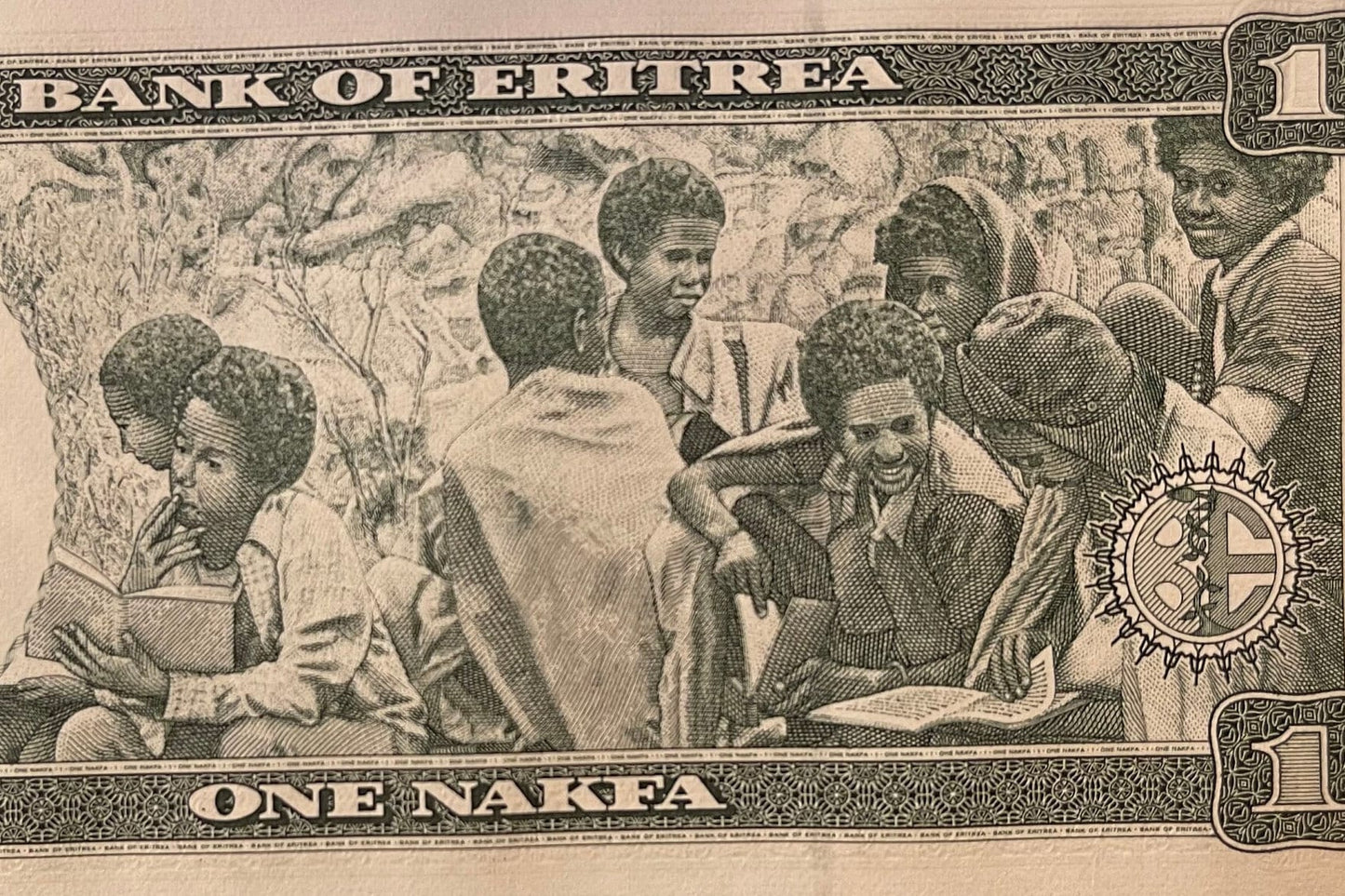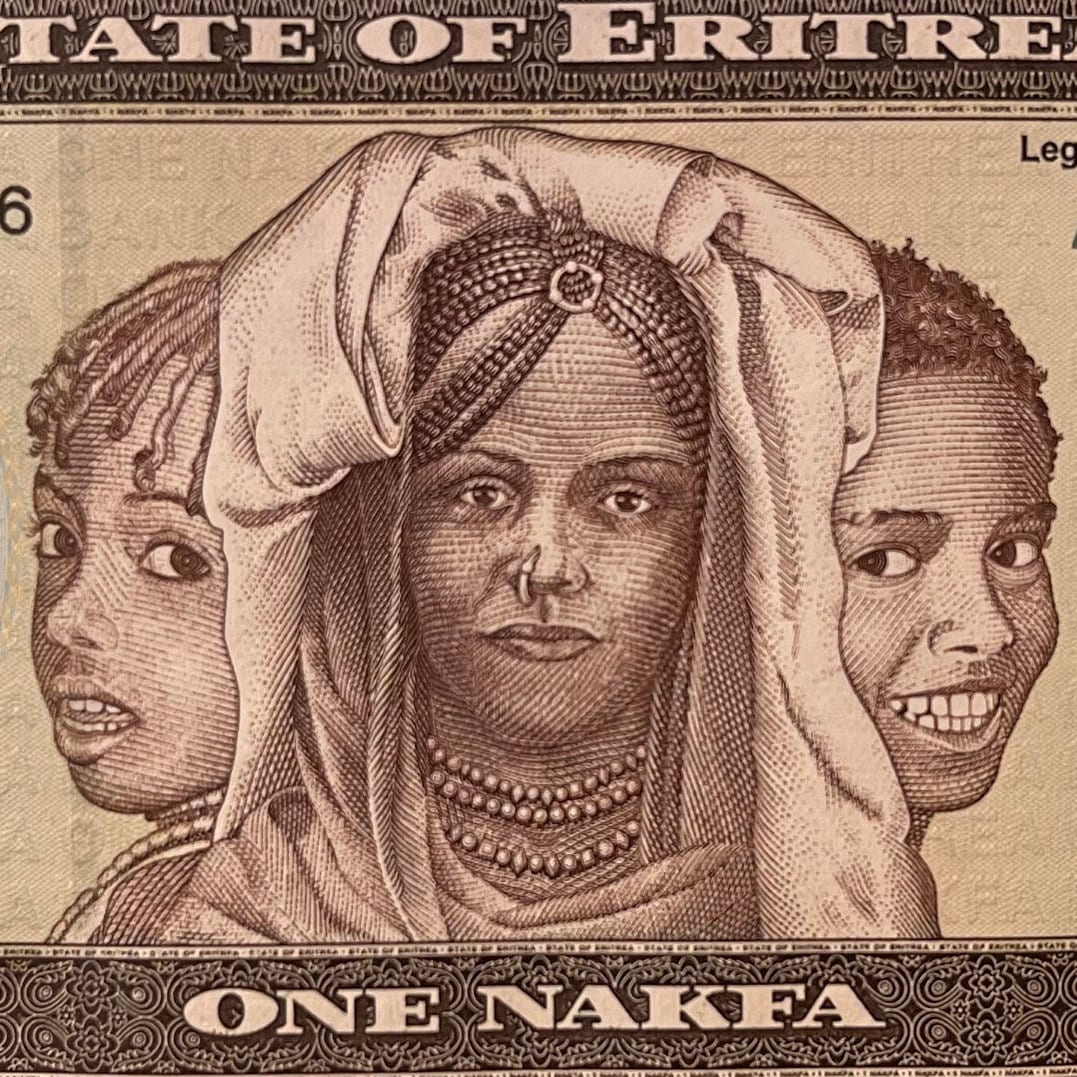elemintalshop
Three Girls & Youth Reading Books 1 Nafka Eritrea Authentic Banknote Money for Jewelry and Collage (Clarence Holbert) (Camel) Black Lives
Three Girls & Youth Reading Books 1 Nafka Eritrea Authentic Banknote Money for Jewelry and Collage (Clarence Holbert) (Camel) Black Lives
Couldn't load pickup availability
Three Girls & Youth Reading Books 1 Nafka Eritrea Authentic Banknote Money for Jewelry Crafts and Collage (Clarence Holbert) (Camel Watermark) (Bush School)
Obverse: Triptych portrait of three children of Eritrea's nine nationalities; flag raising.
Lettering: 1 STATE OF ERITREA 1
Legal tender of Eritrea
AP 4822364 AP 4822364
ናቕፋ نقفة
(signatures) 24.5.1997
1 ONE NAKFA 1
Designer: Clarence Holbert
Reverse: Children in bush school.
Lettering: 1 BANK OF ERITREA 1
1 ONE NAKFA 1
Designer: Clarence Holbert
Watermark: Camel head
Features
Issuer Eritrea
Period Republic (1993-date)
Type Standard banknote
Year 1997
Value 1 Nakfa
1 ERN = USD 0.07
Currency Nakfa (1997-date)
Composition Paper
Size 140 × 70 mm
Shape Rectangular
Number N# 203224
References P# 1
CLARENCE HOLBERT (1944-2018)
-- Source: https://www.blackpast.org/african-american-history/clarence-holbert-1944-2018/
Clarence Holbert is best known as the chief designer of Eritrea’s currency and the second African American engraver to work at the US Bureau of Engraving and Printing. Born in Rutherfordton, North Carolina, Holbert was raised in Washington D.C.’s Northeast neighborhood of Ivy City. Though he spent most of his childhood doodling and drawing the scenery for school plays, Holbert further developed his artistic talent during military service and as an art student.
In 1968, Holbert attended Federal City College while working as a security guard for the Bureau of Engraving and Printing. During long shifts, he left doodles around the workplace, eventually gaining a reputation among his coworkers. When an engraving apprenticeship at the Bureau became available, Holbert was offered the position. Working under the tutelage of his mentor, Ronald Sharp, Holbert became adept at designing banknotes, becoming the nation’s second African American currency designer. In his new role, Holbert gained recognition for designing stamps, Purple Hearts, White House invitations, and ID cards for the CIA and FBI.
In 1994, Eritrea requested Holbert’s expertise in designing the newly independent nation’s currency. After receiving the request, Holbert went to Howard University and made four separate trips to Eritrea to conduct research for the project. From his research, he learned his design should not include government officials or depictions of war. He decided to keep the bill sizes uniform so that Eritreans would read them, thereby improving the nation’s dwindling literacy rates. To come up with his design, Holbert studied hundreds of photographs of Eritrea, from children studying, to camels grazing in vast landscapes. He submitted his sketches in September 1996. After reviewing his work, Eritrean President Isaias Afwerki, and his cabinet informed Holbert that his designs unintentionally included faces from each of Eritrea’s distinct ethnic groups. The Eritrean President and cabinet accepted the design.
The nakfa, Eritrea’s currency, which debuted in 1997, is named after the site of the first major victory in Eritrea’s War of Independence. Holbert’s work was extremely personal for the citizens of Eritrea, whose memories of war were still fresh. Holbert’s design celebrates the beauty and resilience of Eritrean women who are depicted on many of the bills. Making up 30% of the resistance fighters, Eritrean women played a major role in the movement for independence. Holbert’s money imbued the nation with a sense of national pride and formalized their hard-earned separation from Ethiopia.
After designing the nakfa, Holbert retired. He refused an academic position offered by the Eritrean government geared toward training other artists. Instead, he became deeply involved in his church, was ordained, and served as a minister the remainder of his life. In 2018, at age 73, Holbert died of pancreatic cancer. At his memorial service, his family placed a nakfa in his pocket, stating he believed it to be one of his proudest achievements.
*******
The American Man Who Designed Eritrea's National Currency
By Charles W. Corey
Source: http://www.madote.com/2015/01/the-american-man-who-designed-eritreas.html
Washington -- Designing Eritrea's national currency -- the nakfa -- was a "dream come true" for U.S. banknote designer Clarence Holbert because, in his words, it allowed him to become "part of another country's history and culture."
In a February 10 interview with the Washington File, Holbert proudly took credit for designing the paper money and coinage Eritreans use today. When the newly independent country of Eritrea came to the U.S. Bureau of Engraving in 1994 to ask for help in designing its currency, the Bureau assigned the task to Holbert.
Holbert, who retired from the Bureau in 1998, said the request was a "dream come true in a lot of ways.
"For years, I had tried to get access to work on U.S. currency because I knew it was history being made -- because there are so few times that the American currency has actually been changed. To come up with a new design such as was done in Eritrea, is beyond measure -- just to be able to work on it.... I was amazed and I was thrilled to be part of it."
Holbert -- a Washington native who grew up as a child constantly drawing and scribbling -- said he spent two and a half years designing the paper bills and coins Eritrea would use for money. It took almost the same amount of time to produce the plates and print the money, he said, which was not officially released until November 8, 1997.
As an adult, Holbert continued to hone his artistic skills while working his way through college as a security guard at the U.S. Bureau of Engraving and Printing -- where U.S. banknotes are produced.
"When I was a guard, anything that had a white surface on it, I would draw on it," he said. "People came by and they would collect them." Word got around and Holbert was offered a job as an apprentice banknote designer at the Bureau.
"With it being a new nation, there was not much material available on the country," he said. "What resulted was that many Eritrean artists took about a hundred pictures of everything from farmers tilling their fields to children studying -- people across the whole country going about their everyday lives were represented in the many, many pictures." After working up initial designs based on the pictures, Holbert said he visited Eritrea to get a better understanding of the country and its people.
Arriving in Asmara, Holbert said he immediately realized that Eritrea is an amazing place.
"When I first came there, they were building. I was just amazed that after the war, how they were taking the old war materiel and just making what they needed to meet the everyday needs of the country.
"I was immediately impressed with the informality and friendliness of the Eritrean people," he said. "I was amazed by their building projects underway. Men and women were working alongside each other along with former soldiers.
"I was especially impressed with one gentleman in particular," he said. "When I saw the task in front of him, I realized that he had a character in his personality like everyone else in that country. I quickly realized that these people just had not taken time to sit down and think about failure. That attitude," he noted, "had come about through the long war. There was like a steel resiliency in the people and in this young man that said 'Failure is just not part of what we are looking at. It does not matter how long it will take us to accomplish our goal, we will bring it about.' I was just amazed by that."
What was very apparent, he said, was Eritrea's ability to use old and new things to bring about a change in the country. "You could just see the improvement taking place. It seems that they had gotten beyond where a lot of the other African countries were -- where there was a lot of infighting amongst themselves. The Eritrean people were united and moving forward," towards a single goal.
Holbert said he had been privileged to meet with the person who authored Eritrea's declaration of independence and constitution. "I was amazed because I began to realize that I was being allowed to become part of another country as it came into being. Just like our country fought and got our freedom.... I was in awe once I sat down and realized what was actually going on.
"To me," he added, "it showed the determination of a people to establish an identity for themselves in a world and they have included everybody in it." Holbert proudly noted that all the country's ethnic groups are represented in the designs on the money.
The currency, Holbert recalled, "features the everyday people of Eritrea because Eritrean President Isaias Afwerki had given specific instructions that the money not feature cabinet or government officials or their relatives." The president, Holbert explained, wanted the new money to reflect the common people. Additionally, he said, the president did not want the money to be in color but wanted all the notes to be the same size. He wanted his people to be able to read the bills easily.
While all the bills are the same color and size, Holbert said, they do "tie together" in their design.
On the front of each note is a small drawing of the raising of the Eritrean flag during the decisive battle for the country's independence. The money takes its name, the nakfa, from the site of that historic conflict.
Holbert said the money was designed and issued in a 1, 5, 10, 20, 50 and 100 denomination both in bills and coins. Once designed, the yellow, brown and green nakfa bills, which give off a flesh tone color, were printed in Frankfurt, Germany and the coins minted in England.
Asked what it felt like to be involved in this project as an African-American, Holbert said, only one word describes it: "awesome."
On one of his trips to Asmara, Holbert said "I was there at the airport after a long flight from Washington. I was paged and I raised my hand to answer the page. The Eritreans who met me at the airport came over and hugged me. One of them told me 'You don't know how good it made us feel to see that it was one of us who designed our currency.' The very next morning," he said, "a person very high up in the government came to my hotel, hugged me and said, 'Welcome home.'"
"That melted my heart. Being a black American in the United States -- you know -- the things you go through... doing such a deed for the people of Eritrea, made me feel good that the country has embraced me."
Share
